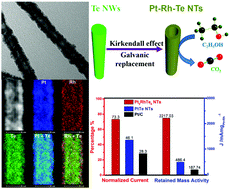Porous Pt–Rh–Te nanotubes: an alleviated poisoning effect for ethanol electrooxidation†
Abstract
Extraordinary attempts have been dedicated to increase the utilization efficiency and catalytic performance and decrease the economy issues related to Pt-based electrocatalysts for fuel cells due to their daunting price, extremely low earth abundance and unsatisfactory catalytic performance for practical applications in the past few decades. Recently, our group successfully synthesized novel one-dimensional (1D) Pt–Rh–Te nanotubes (NTs) as anodic electrocatalysts via a sacrificial template method. The typical 1D nanotubes that comprise porous walls and hollow interiors could be achieved by using PtCl62− and Rh3+ as the metal precursors and Te nanowires as the reductive template in this project. By integrating the multiple compositional and structural merits into one catalyst, more significantly, the mass activities of the as-resulted Pt–Rh–Te NTs/C catalyst were calculated to be 5.08 and 2.98-fold higher than those of commercial Pt/C catalysts and PtTe NTs/C catalysts, respectively. Apart from the excellent catalytic activity when compared with that of the commercial Pt/C catalysts, the optimized Pt–Rh–Te NT electrocatalyst exhibited substantially enhanced long-term stability owing to the combination of a hollow tubular nanostructure and extra incorporation of the Rh element. This work probably provides a general orientation to design and fabricate cost-efficient low-dimensional electrocatalysts.



 Please wait while we load your content...
Please wait while we load your content...